Related Research Articles

Kul Tigin was a general and a prince of the Second Turkic Khaganate.
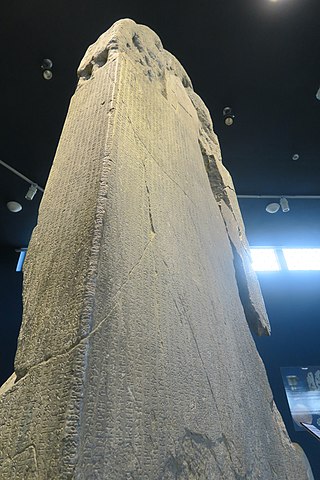
The Old Turkic script was the alphabet used by the Göktürks and other early Turkic khanates from the 8th to 10th centuries to record the Old Turkic language.
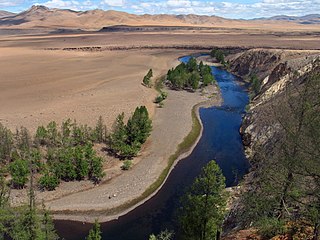
The Orkhon River is a river in Mongolia.

Erdenet is the third-largest city in Mongolia, with a 2018 population of 98,045, and the capital of the aimag (province) of Orkhon. Located in the northern part of the country, it lies in a valley between the Selenge and Orkhon rivers about 240 km (149 mi) northwest of Ulaanbaatar, Darkhan, the capital. The road length between Ulaanbaatar and Erdenet is about 370 km (230 mi).
Old Turkic is the earliest attested form of the Common Turkic languages, found in Göktürk and Uyghur Khaganate inscriptions dating from about the eighth to the 13th century. It is the oldest attested member of the Siberian Turkic branch of Turkic, which is extant in the modern Western Yugur language. It is not the ancestor of the Uyghur language; the contemporaneous ancestor of Uyghur is called Middle Turkic, later Chagatai or Turki.

Orkhon Valley Cultural Landscape sprawls along the banks of the Orkhon River in Central Mongolia, some 320 km west from the capital Ulaanbaatar. It was inscribed by UNESCO in the World Heritage List as representing the development of nomadic pastoral traditions spanning more than two millennia. (See List of World Heritage Sites in Mongolia).

Kurgan stelae or Balbals are anthropomorphic stone stelae, images cut from stone, installed atop, within or around kurgans, in kurgan cemeteries, or in a double line extending from a kurgan. The stelae are also described as "obelisks" or "statue menhirs".

Kharkhorin is a town and sum (district) center in Övörkhangai Province in Mongolia. The sum population was 13,828 (1994), 13,964 (2000), and 14,765 (2017). The population of Kharkhorin town itself was 14,765 in 2017 and covered an area of 20.5 km2.
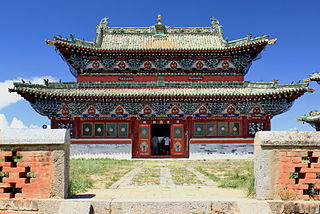
The Erdene Zuu Monastery is probably the earliest surviving Buddhist monastery in Mongolia. Located in Övörkhangai Province, approximately 2 km north-east from the center of Kharkhorin and adjacent to the ancient city of Karakorum, it is part of the Orkhon Valley Cultural Landscape World Heritage Site. The monastery is affiliated with the Gelug sect of Tibetan Buddhism.

The Iron Gate, is a defile between Balkh and Samarkand. It breaks up the mountains which extend from the Hisar range south towards the Amu Darya. In ancient times it was used as the passage between Bactria and Sogdia and was likely of great importance to any power in the region. Its name comes from the belief that an actual gate, reinforced with Iron, stood in the defile. It is located to west from Boysun, Surxondaryo Region. Although its exact location is debatable, it is usually considered to be the 3-kilometre (1.9 mi) pass on the road from Samarkand (Uzbekistan) to Balkh (Afghanistan) and close to Qarshi city. According to historian Lev Gumilev its present name is "Buzgala".

The architecture of Mongolia is largely based on traditional dwellings, such as the yurt and the tent. During the 16th and 17th centuries, lamaseries were built throughout the country as temples which were later enlarged to accommodate a growing number of worshipers. Mongolian architects designed their temples with six and twelve angles and pyramidal roofs approximating the yurt's round shape. Further expansion led to a quadratic shape in the design of the temples, with roofs in the shape of pole marquees. Trellis walls, roof poles and layers of felt were eventually replaced by stone, brick beams and planks.

The Orkhon inscriptions (also known as the Orhon inscriptions, Orhun inscriptions, Khöshöö Tsaidam monuments, or Kul Tigin steles are two memorial installations erected by the Göktürks written in the Old Turkic alphabet in the early 8th century in the Orkhon Valley in what is modern-day Mongolia. They were erected in honor of two Turkic princes, Kul Tigin and his brother Bilge Khagan.

Nikolai Mikhailovich Yadrintsev was a Russian public figure, explorer, archaeologist, and turkologist. His discoveries include the Orkhon script, Genghis Khan's capital, Karakorum and Ordu-Baliq, the capital of the Uyghur Khaganate. He was also one of the founding figures of Siberian regionalism.
The Tariat inscriptions appear on a stele found near the Hoid Terhyin River in Doloon Mod district, Arkhangai Province, modern-day Mongolia.. The stele was erected by Bayanchur Khan of the Uyghur Khaganate in the middle of the eighth century.

The Second Turkic Khaganate, was a khaganate in Central and Eastern Asia founded by Ashina clan of the Göktürks. It was preceded by the Eastern Turkic Khaganate (552-630) and then a period of Tang dynasty rule (630-682). The Second Khaganate was centered on Ötüken in the upper reaches of the Orkhon River. It was succeeded by its subject Toquz Oghuz confederation, which became the Uyghur Khaganate.

The Tonyukuk inscriptions, also called the Bain Tsokto inscriptions are Turkic inscriptions of the 8th century located in modern-day Mongolia. They are the oldest written attestations of the Turkic language family, predating the Orkhon inscriptions by several years.
Orkhon Turkic is the language used in the oldest known written Turkic texts. It is the first stage of Old Turkic, preceding Old Uyghur. It is generally used for the language in which the Orkhon and Yenisei inscriptions are written.
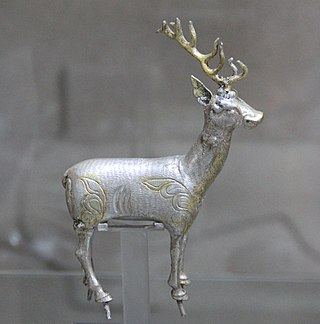
The Silver Deer of Bilge Khan is a 7th- or 8th-century silver and silver-gilt artifact extracted from the tomb of Bilge Qaghan, the burial complex of the fourth Qaghan of the Second Turkic Khaganate. It was discovered in 2001 during excavations carried out in Orkon Valley, at the future Bilge Khan Monumental Grave Complex, located about 400 km (250 mi) from Mongolia's capital Ulaanbaatar, between the Orkhon River and Khosho Tsaydam Lake.
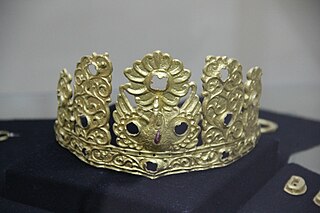
The Crown of Bilge Khan is a golden crown dating to between the 6th and 8th centuries that was unearthed at the complex of Bilge Khan in Khöshöö-Tsaidam, Orkhon Valley, Mongolia. It was created at the time of the Central Asian Second Turkic Khaganate, and is thought to have been manufactured by a local artist. The diadem bears a resemblance to the headgear of the Bust of Kul Tigin.
References
- ↑ Museum of Khushuu Tsaidam. www.touristinfocenter.mn
- ↑ Joint Turkish-Mongolian delegation on the trail of Turkic History in Orkhon Valley
- ↑ Institute of International Affairs, Mongolian Academy of Sciences; Kolyagiin, Demberel (2021-04-26). "Cultural Heritage of Turks in Mongolia and Its Protection: The Issues Revisited". Бюллетень Калмыцкого научного центра Российской академии наук. 1 (17): 54–65. doi:10.22162/2587-6503-2021-1-17-54-65. S2CID 246596229.